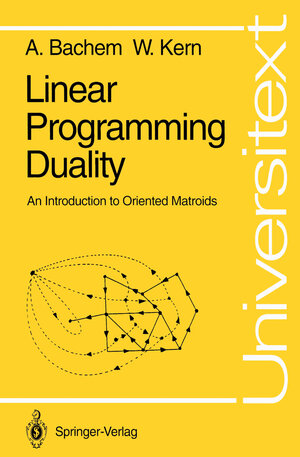
×
![Buchcover ISBN 9783642581526]()
Inhaltsverzeichnis
- 1 Prerequisites.
- 7.1 Sets and Relations.
- 10.2 Linear Algebra.
- 14.3 Topology.
- 15.4 Polyhedra.
- 2 Linear Duality in Graphs.
- 2.1 Some Definitions.
- 2.2 FARKAS’ Lemma for Graphs.
- 2.3 Subspaces Associated with Graphs.
- 2.4 Planar Graphs.
- 2.5 Further Reading.
- 3 Linear Duality and Optimization.
- 3.1 Optimization Problems.
- 3.2 Recognizing Optimal Solutions.
- 3.3 Further Reading.
- 4 The FARKAS Lemma.
- 4.1 A first version.
- 4.2 Homogenization.
- 4.3 Linearization.
- 4.4 Delinearization.
- 4.5 Dehomogenization.
- 4.6 Further Reading.
- 5 Oriented Matroids.
- 5.1 Sign Vectors.
- 5.2 Minors.
- 5.3 Oriented Matroids.
- 5.4 Abstract Orthogonality.
- 5.5 Abstract Elimination Property.
- 5.6 Elementary vectors.
- 5.7 The Composition Theorem.
- 5.8 Elimination Axioms.
- 5.9 Approximation Axioms.
- 5.10 Proof of FARKAS’ Lemma in OMs.
- 5.11 Duality.
- 5.12 Further Reading.
- 6 Linear Programming Duality.
- 6.1 The Dual Program.
- 6.2 The Combinatorial Problem.
- 6.3 Network Programming.
- 6.4 Further Reading.
- 7 Basic Facts in Polyhedral Theory.
- 7.1 MINKOWSKI’S Theorem.
- 7.2 Polarity.
- 7.3 Faces of Polyhedral Cones.
- 7.4 Faces and Interior Points.
- 7.5 The Canonical Map.
- 7.6 Lattices.
- 7.7 Face Lattices of Polars.
- 7.8 General Polyhedra.
- 7.9 Further Reading.
- 8 The Poset (O, ?).
- 8.1 Simplifications.
- 8.2 Basic Results.
- 8.3 Shellability of Topes.
- 8.4 Constructibility of O.
- 8.5 Further Reading.
- 9 Topological Realizations.
- 9.1 Linear Sphere Systems.
- 9.2 A Nonlinear OM.
- 9.3 Sphere Systems.
- 9.4 PL Ball Complexes.
- 9.5 Further Reading.



